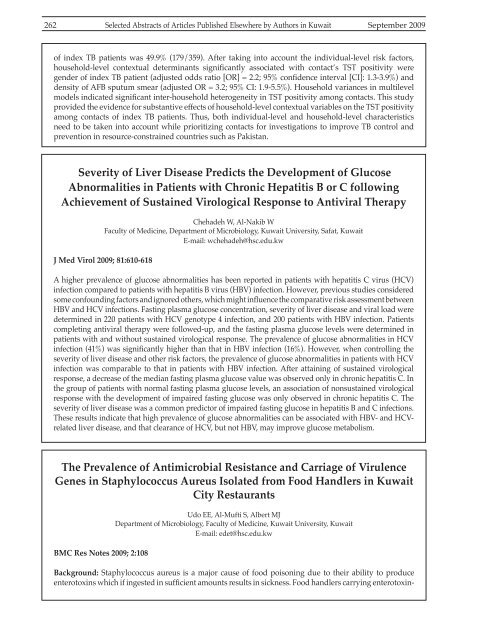Vol 41 # 3 September 2009 - Kma.org.kw
Vol 41 # 3 September 2009 - Kma.org.kw
Vol 41 # 3 September 2009 - Kma.org.kw
Create successful ePaper yourself
Turn your PDF publications into a flip-book with our unique Google optimized e-Paper software.
262<br />
Selected Abstracts of Articles Published Elsewhere by Authors in Kuwait <strong>September</strong> <strong>2009</strong><br />
of index TB patients was 49.9% (179/359). After taking into account the individual-level risk factors,<br />
household-level contextual determinants significantly associated with contact’s TST positivity were<br />
gender of index TB patient (adjusted odds ratio [OR] = 2.2; 95% confidence interval [CI]: 1.3-3.9%) and<br />
density of AFB sputum smear (adjusted OR = 3.2; 95% CI: 1.9-5.5%). Household variances in multilevel<br />
models indicated significant inter-household heterogeneity in TST positivity among contacts. This study<br />
provided the evidence for substantive effects of household-level contextual variables on the TST positivity<br />
among contacts of index TB patients. Thus, both individual-level and household-level characteristics<br />
need to be taken into account while prioritizing contacts for investigations to improve TB control and<br />
prevention in resource-constrained countries such as Pakistan.<br />
Severity of Liver Disease Predicts the Development of Glucose<br />
Abnormalities in Patients with Chronic Hepatitis B or C following<br />
Achievement of Sustained Virological Response to Antiviral Therapy<br />
Chehadeh W, Al-Nakib W<br />
Faculty of Medicine, Department of Microbiology, Kuwait University, Safat, Kuwait<br />
E-mail: wchehadeh@hsc.edu.<strong>kw</strong><br />
J Med Virol <strong>2009</strong>; 81:610-618<br />
A higher prevalence of glucose abnormalities has been reported in patients with hepatitis C virus (HCV)<br />
infection compared to patients with hepatitis B virus (HBV) infection. However, previous studies considered<br />
some confounding factors and ignored others, which might influence the comparative risk assessment between<br />
HBV and HCV infections. Fasting plasma glucose concentration, severity of liver disease and viral load were<br />
determined in 220 patients with HCV genotype 4 infection, and 200 patients with HBV infection. Patients<br />
completing antiviral therapy were followed-up, and the fasting plasma glucose levels were determined in<br />
patients with and without sustained virological response. The prevalence of glucose abnormalities in HCV<br />
infection (<strong>41</strong>%) was significantly higher than that in HBV infection (16%). However, when controlling the<br />
severity of liver disease and other risk factors, the prevalence of glucose abnormalities in patients with HCV<br />
infection was comparable to that in patients with HBV infection. After attaining of sustained virological<br />
response, a decrease of the median fasting plasma glucose value was observed only in chronic hepatitis C. In<br />
the group of patients with normal fasting plasma glucose levels, an association of nonsustained virological<br />
response with the development of impaired fasting glucose was only observed in chronic hepatitis C. The<br />
severity of liver disease was a common predictor of impaired fasting glucose in hepatitis B and C infections.<br />
These results indicate that high prevalence of glucose abnormalities can be associated with HBV- and HCVrelated<br />
liver disease, and that clearance of HCV, but not HBV, may improve glucose metabolism.<br />
The Prevalence of Antimicrobial Resistance and Carriage of Virulence<br />
Genes in Staphylococcus Aureus Isolated from Food Handlers in Kuwait<br />
City Restaurants<br />
BMC Res Notes <strong>2009</strong>; 2:108<br />
Udo EE, Al-Mufti S, Albert MJ<br />
Department of Microbiology, Faculty of Medicine, Kuwait University, Kuwait<br />
E-mail: edet@hsc.edu.<strong>kw</strong><br />
Background: Staphylococcus aureus is a major cause of food poisoning due to their ability to produce<br />
enterotoxins which if ingested in sufficient amounts results in sickness. Food handlers carrying enterotoxin-
















